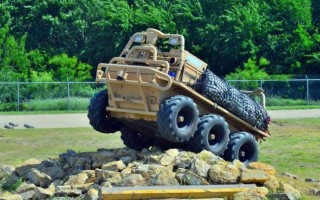Lockheed Martin demos land/air/sea autonomous systems
NewsMay 10, 2017

GRAND PRAIRIE, Texas. Lockheed Martin recently held a demonstration at its Missiles and Fire Control facility in Grand Prairie, Texas, to show the capabilities of its all-weather quadrotor unmanned aerial system (UAS), its new real-time 3-D reconstruction software, and the company's ongoing developments in military and commercial autonomous vehicles.
The Indago 3 demo showed the most recent version of Lockheed Martin’s Indago quadrotor unmanned aerial system (UAS), which the company says enables military customers to securely complete sensitive intelligence, surveillance, and reconnaissance (ISR) missions. Depending on the weight of the payload, Indago 3 has a flight time of up to 50 minutes, a range of just over six miles, and a cruising speed of 25 mph; it is also operational at temperatures as low as 30 degrees below zero and as high as 120 F. Indago is currently used in precision agriculture, during disaster relief and inspections, and by first responders and firefighters. Another of the demonstrations showed the company’s new Hydra Fusion Tools, which construct a coherent 3-D model of the area below during flight, in real time. Such real-time modeling can be used by military operations, inspections, agriculture, disaster relief, and more.
Another of the presentations included Lockheed Martin’s Squad Mission Support System (SMSS), an unmanned robotic vehicle currently used by the military for unmanned transport and logistical support for light, early entry, and special operations forces. The SMSS can be used in-theater to lighten the warfighter’s load, serve as a power-management resource, and act as a utility platform for various Mission Equipment Packages. An extension of the SMSS is the Lockheed Martin Site Shuttle system, which is an autonomous system that can transport workers around large industrial sites on a fully automated basis; the company say that it could be used in rail yards, ports, depots, and secured sites.
Also displayed was a commercial version of the Stalker XE small UAS, which has been used by the U.S. military around the world for more than 15 years. The highly automated XE enables long-endurance imaging capability throughout an array of operational environments.







